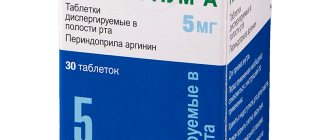Arterial hypertension is a sustained increase in blood pressure above 140/90 mmHg. Art. “Lorista” is an antihypertensive drug that contains losartan.
Lorista
The drug is intended to lower blood pressure, improve quality of life, and prevent cardiac hypertrophy. These manifestations do not go unnoticed, since their symptoms are quite alarming: severe pain in the chest, high blood pressure, angina.
All signs appear, according to the patient, without any reason. To avoid the development of the disease, doctors suggest that patients take the drug “Lorista”: the instructions for use contain all the necessary information about treatment tactics.
Compound
The drug “Lorista” is a drug with a diuretic effect. Its main therapeutic effect is due to the active substance – losartan. Excipients are also used in the production of tablets. The product contains pregelatinized starch, cellactose, and corn starch. The tablets do not lack magnesium stearate and silicon dioxide. Microcrystalline cellulose, a constant component of almost all medications, is also present in Lorist.
The main component of the drug, losartan, blocks angiotensin receptors. The drug has a similar effect on some other systems of the body: on the vessels of the kidneys, the adrenal cortex.
Diuretic effect
“Lorista” for blood pressure is a drug that helps to increase the lumens in the arteries, which leads to a decrease in blood pressure. Two types of medicine are offered for free sale: “Lorista ND” and “Lorista N”. Being a combination type of medicine, these drugs exert their therapeutic effect due to the interaction of two main components - losartan and hydrochlorothiazide. The second element has pronounced diuretic properties.
Mechanism of action
The pharmacological properties of the drug are aimed at suppressing angiotensin, a potent vasoconstrictor and the main hormonal component of the RAAS. This biochemical compound serves as an important link in the formation of the pathological mechanism of arterial hypertension.
Angiotensin enters into a molecular connection with AT1 receptor elements in the smooth muscle fibers of the vascular walls of the adrenal glands and the heart organ. Despite performing a number of important physiological functions, it increases blood pressure.
Lorista (reviews from patients who took the drug note a rapid normalization of AT) and the biochemically active products of its metabolism stop all the negative effects of angiotensin, regardless of the source of its synthesis.
Losartan selectively inhibits AT1 receptors without affecting other hormonal compounds and ion ducts that regulate the functioning of the cardiovascular system. The active component of the drug does not block the angiotensin-converting enzyme involved in the decomposition of the vasodilator peptide.
Losartan potassium normalizes systolic and diastolic blood pressure. When the maximum saturation of the blood plasma with the active substance of the drug is reached, the inhibition of the biochemical activity of angiotensin is about 85%, and after a day with a course of a single dose at a concentration of 100 mg - 26-39%.
Lorista:
- controls blood pressure evenly over 24 hours;
- reduces peripheral vascular resistance in the pulmonary circulation of blood fluid;
- eliminates the afterload of arterial hypertension on the venous walls;
- has a diuretic effect, relieving excess tension from the urinary ducts and the kidney organ;
- prevents myocardial hypertrophy;
- increases physical endurance of patients with CHF.
The antihypertensive effect of losartan potassium fits into the natural circadian rhythm - cyclical fluctuations in the activity of various biological processes in the body.
The drug does not have a clinically significant effect on the frequency of contraction of the heart muscle. Losartan potassium suppresses the negative feedback reaction of angiotensin type 2 to renin synthesis, which causes increased activity of the latter in the blood plasma. The effectiveness of stopping AT1 receptors is evidenced by the suppression (suppression of the biochemical action) of aldosterone.
Reviews from patients who took the drug to normalize blood pressure confirm that after stopping the course of therapy with Lorista, the angiotensin-2 level returns to its original value within 3 days.
Release form
The drug is manufactured in tablet form. Each film-coated pill contains one of the dosage options for the medicinal substance:
- 12.5 mg;
- 25 mg;
- 50 mg;
- 100 mg.
The manufacturer of the drug “Lorista” is the company “KRKA-RUS”, Russia. Each package of pressure relief contains several blisters (2, 3, 6 or 9). One blister contains 7, 10 or 14 tablets. There is a packaging option that contains only one blister with 14 tablets.
KRKA
The medicine should be stored at room temperature not exceeding 25 °C. The drug should be kept away from children. “Lorista” is sold by prescription. The product can be stored for five years from the date of manufacture.
Use by children
Like any other blood pressure drug, in addition to its benefits, Lorista also has harm, so doctors strictly recommend not prescribing it to children under 18 years of age.
As for use during pregnancy, there is no exact data on the effect of the drug on the fetus. But it should be taken into account that renal perfusion begins to work in the fetus in the 3rd trimester; this function depends on the state of development of the renin-angiotensin system. Therefore, taking the drug may carry certain risks for the fetus in the second and third trimesters.
During breastfeeding, it is worth considering the potential threat to the baby's health, since there is no data on how Lorista is excreted in breast milk.
Pharmacodynamics and pharmacokinetics
The active substance due to which “Lorista” has a therapeutic effect is losartan. It blocks angiotensin II receptors, which are located in the heart, kidneys, adrenal cortex and blood vessels. It is also important that Lorista reduces the risk of myocardial hypertrophy.
Myocardium
The drug is concentrated to its maximum in the blood 1 hour after administration. Admission is carried out orally. Metabolites formed in the liver after taking the medicine become active after 2.5-3 hours.
Since “Lorista N” and “Lorista ND” are drugs that have a diuretic effect, they affect the second stage of urine formation in the body. Manifestations of the drug's effect can be noted within 1-2 hours after administration. This concerns the diuretic effect. The hypotensive effect develops a few days after taking the first tablet; subsequently, a daily dose of the drug maintains the effect.
Blood pressure decreases gradually when taking Lorista. Blood circulation is slowly normalized. This rate of recovery is most preferable for the patient, because a sudden change in condition is most often stressful for the body.
Using Lorista to lower blood pressure provides patients with a number of benefits:
- one-time use – there is no need to carry the drug with you and take it throughout the day;
- decrease in plasma volume due to the diuretic effect of the drug.
With systematic use of the drug “Lorista”, the pressure quickly returns to normal. The patient's condition is restored, and the quality of life becomes much better.
The principle of operation of the substance
The use of the medicine leads to a gradual decrease in pressure and normalization of blood circulation. Due to its mild effect, it is successfully used by patients with heart failure, while increasing the possibility of physical activity.
Advantages of use:
- The drug is taken once a day, normal blood pressure is maintained for a long time due to the accumulation of substances. Against the background of a pronounced decrease in blood pressure, arrhythmia or bradycardia does not occur.
- An important feature of Losartan is the absence of blockade and binding of ion channels, which contribute to the stable functioning of the cardiovascular system.
- The active component does not affect the autonomic reflex and does not increase the amount of norepinephrine in the blood.
- Due to the diuretic effect, the total plasma volume decreases, renin activity increases, and potassium is excreted from the serum into the urine with a corresponding decrease in its quantitative characteristics.
Indications for use
The use of any medicinal product must be for medical reasons. For the use of “Lorista” it is:
- hypertension;
- severe left ventricular hypertrophy leading to increased blood pressure;
- hypertension;
- heart failure.
Tonometer
Attention! “Lorista” is a worthy representative of the group of antihypertensive drugs, because it can also be used for patients suffering from renal failure and diabetes.
How does it affect blood pressure?
The blood pressure drug Lorista acts on angiotensin receptors localized in the brain, adrenal glands, pulmonary, cardiac, renal tissue structures, and blood vessels.
As a result, the production of the hormone aldosterone is suppressed, which retains fluid and salt in the kidneys, which provokes an increase in blood pressure (BP).
A powerful antihypertensive effect is achieved due to the vasodilating properties of the drug and the ability of its active components to reduce the volume of blood contained in the kidneys.
The hypotensive effect of the tablets is combined with diuretic properties, so Lorista quickly reduces blood pressure and also fights hypertrophy of the heart muscle that occurs in patients suffering from chronic arterial hypertension.
An improvement in the patient's condition is noted within 2 hours after using the drug.
With prolonged use (3 weeks or more), Lorista hypertension tablets stabilize blood pressure, eliminate swelling and other characteristic painful symptoms.
Indications for taking tablets
Doctors recommend the use of Lorista for blood pressure in the following clinical cases:
- Chronic heart failure;
- Hypertension, accompanied by persistently elevated blood pressure;
- Acute form of myocardial infarction;
- Processes of a congestive nature that occur as a result of heart failure.
- Left ventricular hypertrophy;
- Proteinuria;
- Arterial hypertension.
The drug is suitable for both long-term and periodic use to normalize high blood pressure. Lorista tablets are also prescribed to patients diagnosed with diabetes mellitus to protect and maintain the functions of the renal apparatus.
Mechanism of action of angiotensin receptor blockers
Contraindications
Before prescribing Lorista, the attending physician must ensure that the patient has no contraindications. Like any other blood pressure medications, this drug has the ability to lower blood pressure, which, if used incorrectly, can lead to additional health problems.
Important! Under no circumstances should you purchase medications that lower blood pressure on your own, without consulting a cardiologist. They all have different operating principles, so selection can only be carried out by a specialist.
Alcohol ban
When using Lorista, you should keep in mind that taking alcohol-containing substances is strictly prohibited. Alcohol and losartan are incompatible. Ethanol promotes the appearance of “side effects” and also has a leveling effect on the main components of the drug. In other words, the pill simply will not have any therapeutic effect.
The use of Lorista in the treatment of hypertension does not entail a ban on driving vehicles or performing work that requires increased concentration.
The main contraindications taken into account when prescribing this drug are as follows:
- allergy to lactose;
- sensitivity to some components of the drug;
- minor age;
- pregnancy status;
- dehydration of the body;
- lactation period;
- increased potassium levels;
- reduced blood pressure.
If the patient notes at least one of the above factors, the use of Lorista in the treatment of high blood pressure is prohibited.
Possible adverse reactions
Side effects that occur during Lorist therapy are reversible and disappear after the drug is removed from the bloodstream during drug withdrawal. The most common adverse reactions:
- Losartan is used with caution in persons with a history of allergic reactions: angioedema of the face and its individual parts. Quincke's edema and anaphylactic shock may occur.
- Arterial hypotension occurs when a single dose is exceeded and against the background of dehydration due to concomitant vomiting and diarrhea of both infectious and non-infectious origin. The condition is treated by dose adjustment or complete withdrawal of the drug.
- In case of renal failure, diabetes mellitus, diseases of the cardiovascular system, it is necessary to carefully monitor the water and electrolyte balance.
Attention! It is not recommended to take additional potassium supplements.
- Liver cirrhosis and moderate organ dysfunction are indications for dose reduction. In severe cases, the use of the drug is contraindicated.
- Kidney failure can occur against the background of existing organ pathology.
- Use with caution in people with coronary heart disease; a rapid drop in blood pressure can trigger the development of a stroke or heart attack.
The simultaneous use of drug components with ethyl alcohol is not allowed. The effect of alcohol poses a threat to the patient’s life due to the development of stroke and myocardial infarction. The disease can be fatal.
The effect of Lorist on driving has not been studied, however, at the beginning of therapy, headache and weakness may occur due to a decrease in blood pressure.
Side effects
If there are no obvious contraindications for the use of the described drug and hypertension therapy has been started, you should carefully listen to the body’s signals. In some cases, side effects may occur. Almost all systems of the body can respond to the appearance of a new component:
- Nervous system. The side effect manifests itself in decreased performance, the appearance of insomnia or, conversely, drowsiness, increased levels of anxiety and severe headaches;
- The cardiovascular system. It is expressed in a decrease in blood pressure to critical levels, the process is accompanied by an increase in heart rate;
- Digestive system. This type of disorder is characterized by manifestations of dyspepsia: nausea, vomiting, abdominal pain and diarrhea;
- Respiratory system. Swelling of the nasal mucosa, bronchitis, cough, pharyngitis may occur;
- Reproductive system. The patient may notice a decrease in libido. Erectile dysfunction;
- Musculoskeletal system. Disorders of this type are characterized by symptoms such as arthralgia, myalgia, cramps and pain in the arms and legs;
- Hematopoietic system. A side effect from using Lorista is anemia;
- Dermatology. Patients experience redness of the skin, increased photosensitivity, increased dryness of the hands, increased sweating;
- Sense organs. On this side, there may be a disturbance in visual, auditory and taste perception, a feeling of ringing in the ears;
- The immune system. Disturbances in its functioning are manifested in possible allergic reactions: urticaria, itching of the skin, Quincke's edema.
Increased anxiety
Metabolism may also be affected by losartan.
To avoid unpleasant consequences, it is necessary to approach the choice of the drug as carefully as possible. If side effects occur, symptomatic treatment should be carried out and, if possible, the drug should be replaced with a similar one.
Possible adverse reactions
During the therapeutic course, Lorista may cause the following adverse reactions:
- Muscle pain;
- Hypokalemia;
- Constipation:
- Weakness and increased fatigue;
- Visual impairment;
- Cough syndrome;
- Angina;
- Disorders of sleep and natural biorhythms (insomnia at night, drowsiness during the day);
- Dizziness;
- Nausea and vomiting;
- Disturbances in the functioning of the digestive system;
- Manifestations of an allergic nature;
- Increased heart rate (tachycardia);
- Difficulty in breathing;
- Vertigo;
- Headache;
- Convulsive syndrome;
- Feeling of noise and ringing in the ears;
- Convulsive syndrome:
- Painful sensations localized in the back and chest;
- Depressive states;
- Violation of potency in representatives of the stronger sex.
In especially severe cases, side effects such as the development of a hypotensive crisis (a sharp and too strong decrease in blood pressure), angina pectoris, and bradycardia are possible.
Method and dosage
At what pressure and how to take it? Lorista must be taken orally. There is no dependence on food intake, but it is important to take the drug with plenty of clean drinking water. The recommended time to take the drug is the first half of the day.
The average dose recommended for use is 50 mg. By following such a treatment plan, the patient will be able to achieve the maximum hypertensive effect 20-40 days after the start of therapy.
The effect can be enhanced, but for this the daily dose is increased to 100 mg. The amount of the substance should be increased gradually and only under the supervision of a doctor. The dose escalation scheme is as follows:
- 1 week – 12.5 mg;
- 2 week – 25 mg;
- 3 week – 50 mg;
- Week 4 – 50 mg.
If the patient has impaired renal function, then the amount of active substance remains at 20 mg/day for the entire period of therapy. There is no need to increase the dose for patients over 60 years of age.
What is better to take: analogues
Let's consider the main analogues of the drug and their features.
Lorista or Lorista N
What does Lorista N help with? This drug also has a pronounced hypotensive effect. In addition to losartan, it contains hydrochlorothiazide. This substance is a diuretic, the action of which occurs due to the disruption of the reabsorption of chloride, sodium, potassium and other ions. Hydrochlorothiazide provokes dilation of arterioles. Because of this, blood pressure levels decrease.
Important! The cost of Lorist N is 260–710 rubles, depending on the dose of the drug.
The diuretic effect of hydrochlorothiazide is observed 1 hour after entering the human body. The maximum concentration of this substance is observed after 4 hours. Stabilization of blood pressure occurs 3 days after starting the combination drug. A lasting therapeutic effect occurs only after a month of treatment.
Lozap or Lorista
If necessary, its substitutes can be used instead of Lorist. Lozap is considered such a drug. This medication also contains losartan, which produces an antihypertensive effect.
Important! The price of Lozap in the pharmacy chain ranges from 240 to 750 rubles, depending on the dosage and number of tablets in the pack.
This drug is used in the same way as Lorista. When used in patients with kidney or liver problems, in some cases it is recommended to reduce the daily dose to 25 mg.
Lorista or Lisinopril
The analogue has lisinopril in an amount of 10 or 20 mg as the main active ingredient. It is used for high blood pressure, including those caused by diabetes and heart failure.
Important! The cost of Lisinopril is 129–151 rubles.
This drug is used with caution in the presence of renal failure, autoimmune diseases, aortic stenosis and other pathological conditions.
Losartan or Lorista
Losartan is one of the analogues of Lorist. This substitute is used in the same way as the main medication. It is taken as the main component of treatment or as part of complex therapy.
Important! The cost of Losartan is 140–315 rubles.
This remedy is used according to a special scheme depending on the disease. It is recommended to take 1 tablet of Losartan per day, but with different dosages.
Lorista or Enalapril
Enalapril is an ACE inhibitor. Used to reduce blood pressure, in heart failure, and to prevent the development of ischemia. At first, the dose of the drug is 2.5 mg. After some time, the amount of the drug is increased to 10–20 mg per day.
Important! The cost of Enalapril is 14–47 rubles.
This drug is contraindicated for pregnant and lactating women, children and adolescents. It is not used for stenosis of the hepatic arteries, hyperkalemia, porphyria.
Lorist's analogues are a worthy replacement. The best drug can be selected by a doctor who is able to take into account all the characteristics of the sick person. Choosing treatment on your own is dangerous to your health.
Overdose
As with any medicine, when taking Lorista you must exercise maximum attention to prevent an overdose of the drug. If this happens, the patient may experience the following symptoms:
- decreased blood pressure;
- tachycardia;
- bradycardia.
It is necessary to eliminate the manifestations of an overdose of the drug “Lorista” through symptomatic therapy. It is recommended to carry out forced diuresis (forced urination). Hemodialysis in case of exceeding the dose of this drug is ineffective.
When consuming an increased amount of losartan, symptoms may appear that will indicate excessive fluid loss. If the simultaneous use of cardiac glycosides is not stopped, the resulting hypokalemia may aggravate the course of the arrhythmia. In this case, symptomatic treatment should be aimed at restoring water balance in the body.
Drug interactions
Combining Lorista with other antihypertensive drugs as part of complex therapy leads to an enhanced pharmacological effect. Parallel use of the drug with Fluconazole and Rifampicin reduces the content of biochemically active metabolic products of losartan potassium.
The simultaneous use of Lorista with diuretic and non-steroidal anti-inflammatory drugs minimizes the hypotensive effect.
You cannot combine tablets with:
- tricyclic antidepressants;
- neuroleptics;
- centrally acting muscle relaxants;
- cytoprotectors.
They increase the likelihood of arterial hypotension. Simultaneous use of Lorista with selective blockers of the COX-2 enzyme weakens the clinical effect of the tablets.
Interaction
There is a group of drugs for which no clinically significant signs of interaction with losartan have been identified. This:
- digoxin;
- hydrochlorothiazide;
- cimetidine;
- warfarin;
- phenobarbital.
Rifampicin has the ability to reduce plasma concentrations of losartan. Its use simultaneously in Lorista should be under the supervision of a physician.
Regarding other medicinal components, experts note the following:
- ketoconazole does not affect the metabolism of losartan;
- erythromycin has no effect on the components of Lorista when taken orally;
- fluconazole can reduce the concentration of losartan in the blood;
- simultaneous use of losartan with potassium-sparing diuretics leads to an increase in the amount of potassium in the blood;
- non-steroidal drugs with anti-inflammatory effects can reduce the antihypertensive effect of Lorista;
- if renal function is impaired, simultaneous use of non-steroidal anti-inflammatory drugs can lead to a worsening of the situation;
- Lorista should not be used simultaneously with aliskiren (or with drugs containing it) in the treatment of patients with diabetes mellitus or renal failure.
Salt substitutes
During therapy with Lorista, you should not use potassium-sparing diuretics. Potassium supplements and table salt substitutes are also contraindicated.
For what diseases should it be taken?
Treatment of hypertension of 1-3 degrees, prophylactically prevents the development of complications in the presence of serious cardiac pathologies in the patient's history, use is indicated for chronic heart failure, against the background of pathological conditions of the kidneys to normalize laboratory parameters.
Who is contraindicated for:
- persons with an allergic reaction to components,
- pathology of the biliary tract,
- pregnant and lactating women,
- with renal failure,
- in the absence of urine.
The product can be used either independently or to enhance the effect of drugs with a similar effect.
What you should pay attention to:
- Combination with potassium-sparing diuretics, salt substitutes and potassium supplements is not recommended due to the risk of increasing the substance in the blood serum.
- Combined use with rifampicin and fluconazole reduces the concentration of the drug.
- NSAIDs (nonsteroidal anti-inflammatory drugs) may reduce the therapeutic effect.
- In combination with diuretics, dynamic monitoring of renal function is required, especially against the background of a corresponding pathology in the patient’s medical history. In older adults, adequate hydration should be maintained throughout treatment. The condition of deterioration in kidney function is reversible and disappears after replacing the medicine with another one.
- Concomitant use with neuroleptics and antidepressants leads to hypotension.
Analogs
If contraindications for the use of the described drug are found, as well as if side effects occur, it is necessary to select a replacement with a similar effect and change the drug to a similar one. Such medicines are:
- “Vasotens”;
- “Lakea”;
- “Lotor”;
- “Blocktran”;
- “Presartan”;
- “Zisakar”;
- "Renicard";
- “Brozaar.”
Important! Only a doctor can select a similar medication. You cannot change a drug that has a serious effect on the body on your own.
High blood pressure is a direct indication for the use of Lorista. It can help the patient cope with hypertension, as well as prevent heart failure and reduce the risk of myocardial infarction. Losartan inhibits angiotensin receptors in the heart muscle, which helps reduce vasoconstriction.
Restrictions and contraindications
The medicine has a number of limitations. Due to the extensive list of contraindications, it is often replaced with analogues and substitutes with a less aggressive effect. Do not take under the following conditions:
- pregnancy, breastfeeding;
- impaired absorption of glucose;
- arterial hypotension;
- hyperkalemia;
- hypotension;
- lactose intolerance.
It is forbidden to take if you are hypersensitive to the main active ingredient, and if you are hypersensitive, the dosage should be reduced. The medicine is not prescribed to children and adolescents under eighteen years of age with impaired liver function. Take with caution in case of liver failure, bilateral renal artery stenosis, or decreased blood volume.
The drug conflicts with an extensive list of medications; without a doctor’s prescription, you should not supplement the therapy yourself.
Side effects include dizziness and hyperkalemia. Swelling and urticaria may occur. From the gastrointestinal tract, diarrhea and bloating are observed. Itching and headache are common. Symptomatically, adverse reactions are not treated, Lorista is excluded and an analogue is prescribed.
Interaction with other drugs
Lorista tablets, prescribed to lower blood pressure, are often used in various combinations with diuretics and cardiac glycosides.
To reduce the risk of stroke, if the patient is diagnosed with arterial hypertension or left ventricular hypertrophy, a dose of 50 mg is usually prescribed at the beginning of the course. You can gradually increase the dose of the drug or introduce small doses of hydrochlorothiazide into the complex of drug treatment.
If potassium preparations or diuretics are used simultaneously with Lorista, which do not remove it from the body, then the content of this microelement in the blood may increase.
If other antihypertensive drugs are used as part of complex therapy, the effect of lowering blood pressure may be enhanced.
Anti-inflammatory drugs reduce the effectiveness of Lorista in lowering blood pressure.
Lorista - analogues and generics
“Lorista,” as the instructions for use say, is itself an analogue of “Kozaara,” but with good reviews and an affordable price. The original “Kozaar” is a product, and “Lorista” is produced in Slovenia, by the famous company KRKA.
Currently, the following analogues of Lorista can also be purchased in the Russian Federation:
- “Presartan” - India, “Ipka” - from 131 rubles.
- "Losartan Canon" - produced by the domestic JSC "Canonpharma Production" - from 100 rubles;
- “Vasotens” Icelandic, from 140 rubles;
- "Bloktran", RF, "Pharmstandard", from 145 rubles. per package 50 mg No. 30;
- “Lozarel” produced by “Lek”, Slovenia, from 177 rubles.
An analogue of Lorista-N is also presented on the market. This is, for example, “Lozap plus”.
Currently, there is a wide choice of drugs to reliably prolong the life of a patient suffering from heart failure and hypertension, against the background of increased cardiac risk. The most important thing is that treatment is not limited to taking drugs in advanced stages, but is largely preventative and prevents the development of high coronary risk.
Source: zdorova-krasiva.com
Lorist's instructions
Lorista (active ingredient - losartan) is an antihypertensive drug, an angiotensin II receptor blocker with selective action (it exhibits antagonism exclusively to AT1 type receptors). Medicines for the treatment of cardiovascular diseases are today, perhaps, the most popular part of the pharmacy assortment, occupying the largest area on display windows. This is not surprising: cardiovascular pathology is currently firmly entrenched in the sole leading position in the structure of overall mortality, exceeding similar indicators from all other possible causes combined. The antihypertensive effect of Lorista is based on the ability of the drug to erect an insurmountable barrier between AT1 receptors and angiotensin II, thereby blocking all physiologically significant effects of the latter, regardless of the route of its formation in the body. Thus, angiotensin II cannot realize its remarkable vasopressor potential, although its amount does not decrease, as occurs with treatment with angiotensin-converting enzyme inhibitors. It is important that, unlike the latter, Lorista does not inhibit the enzyme kininase II, which is involved in the metabolism of bradykinin. As a result, there is no accumulation of excess bradykinin, which avoids the associated side effects of cough and angioedema. Lorista reduces total peripheral vascular resistance, pressure in the pulmonary circulation, reduces afterload on the myocardium, and has a moderate diuretic effect. The drug prevents the development and progression of left ventricular hypertrophy (a predictor of cardiovascular events) and increases resistance to physical exercise in patients suffering from chronic heart failure. In order to achieve a clinically significant reduction in systolic (upper) and diastolic (lower) blood pressure, it is enough to take Lorista once a day. The drug maintains blood pressure at a given level throughout the day, without sudden changes and in accordance with the natural circadian rhythm.
The decrease in blood pressure at the end of a single dose of Lorista is about 70-80% of the antihypertensive effect 5-6 hours after administration, when the peak effect of the drug is noted. The drug does not cause a reflex increase in heart rate and a rebound increase in blood pressure after cessation of pharmacotherapy. Lorista is effective in patients regardless of their gender and age. One of the main studies demonstrating the effectiveness of the drug in arterial hypertension was the multicenter randomized LIFE trial. It involved more than 9 thousand patients who, in addition to persistently elevated blood pressure, also had left ventricular hypertrophy. Study participants were divided into two groups taking losartan (Lorista) and atenolol, respectively. When analyzing the study results, it was found that mortality in the losartan group was almost two times lower than in the atenolol group. Patients in the losaratan group were less likely to develop cardiovascular events such as ischemic stroke and acute myocardial infarction. The dynamics of the decrease in blood pressure were comparable in both groups, while in the losaratan group, patients experienced a much more pronounced regression of left ventricular hypertrophy. Thus, Lorista has proven to be a more promising drug in the treatment of arterial hypertension than atenolol. In general, Lorista, as well as all sartans (as the group of angiotensin II receptor blockers is more compactly called), is better tolerated than other groups of antihypertensive drugs. If we talk exclusively about losartan (lorist), then this drug has the most solid evidence base among all sartans, being the most studied representative of this group of drugs and having the largest number of indications for use.
Lorista is an antihypertensive drug that helps reduce total peripheral resistance in blood vessels and blood pressure in the pulmonary (pulmonary) circulation. The pressure is reduced by dilating small arteries. Lorista stops the development of left ventricular hypertrophy of the heart, suppressing its symptoms such as shortness of breath, angina pectoris, palpitations, drowsiness and fatigue; with concomitant heart failure, increases tolerance to physical activity. The antihypertensive effect of the drug does not affect the body's circadian rhythms and is uniformly stable over 24 hours. Lorista has a diuretic effect, which occurs 1-2 hours after administration and lasts for 6-12 hours.
Reception regimen:
Contraindications:
Side effects:
Active ingredient : losartan potassium
Auxiliary components : MCC, cellactose, pregelatinized corn starch, Aerosil, magnesium stearate.
Release forms:
Lorista anti-pressure drug
- 1 Hypertension is the main indication for taking the drug "Lorista" 1.1 Composition, description, action and release form
- 1.2 Pharmacodynamics and pharmacokinetics
- 1.3 Indications for use
- 1.4 Instructions for use of "Lorist" for pressure 1.4.1 Is it possible for children?
- 1.4.2 What if prescribed during pregnancy and lactation?
Have you been struggling with HYPERTENSION for many years without success?
Head of the Institute: “You will be amazed at how easy it is to cure hypertension by taking it every day...
Read more "
Lorista tablets are prescribed to lower blood pressure. The drug is also used and helps with heart failure. The main advantage of using the drug is the prevention of stroke, because it is well absorbed in the body and accelerates metabolic processes. Like all medications, it has contraindications and compatibility issues with other medications.
Hypertension is the main indication for taking Lorista.
Composition, description, action and release form
The active ingredient of the drug is losartan. It blocks receptors that lead to high blood pressure. When diagnosing heart failure, it increases physical endurance. After administration for an hour, the maximum percentage of concentration of the active component in the blood is observed. Another active ingredient is hydrochlorothiazide. It has diuretic and hypotensive effects and is found in combination medications: Lorista N (100 plus 12.5 mg) and ND (100 losartan + 25 mg hydrochlorothiazide). The hypotensive effect of the drugs begins no earlier than 3 days later, while the diuretic effect is felt within an hour after administration. Excipients are: starch, lactose and magnesium stearate. Form: oval yellow-orange tablets of 12.5, 25, 50 and 100 mg. The package contains 3, 6 or 9 blisters of 10 tablets each.
on
Return to contents
Pharmacodynamics and pharmacokinetics
The drug "Lorista" belongs to the group of angiotensin 2 receptor blockers. The action of the drug occurs in the heart and blood vessels, kidneys. As a result of exposure, it lowers pressure in the body. Valid throughout the day. The medicine is quickly absorbed by the digestive system. In alcoholic cirrhosis, the concentration of losartan in the blood increases. Therefore, if liver function is impaired, it is necessary to reduce the dose of the drug. It is not excreted by hemodialysis. The active component is processed by the liver and excreted mainly with bile, the rest is excreted by the kidneys.
Return to contents
Indications for use
The drug can be used for type 2 diabetes.
The drug can be combined with antihypertensive drugs. The duration of use is determined by the attending physician. Lorista tablets are prescribed to reduce the risk of stroke due to high blood pressure (hypertension), gout, as well as such pathologies as:
- chronic heart failure (CHF);
- type 2 diabetes.
Return to contents
Instructions for use of "Lorist" for pressure
The official instructions for use indicate:
- Diabetics are prescribed 1 tablet per day. If blood pressure does not fall during treatment, then increase the dose to 100 mg.
- For heart failure, 12.5 mg is initially used, and then the dose is gradually increased.
- In case of increased BCC (blood circulation volume), it is prescribed to start taking it with a dosage of 25 mg. It is better for such people to start Lorista therapy after stopping diuretics and normalizing hypovolemia. Cannot be used with Hypothiazide. The same initial dosage is used for elderly people over 75 years of age.
- In case of kidney problems, the drug should be taken as usual, and in case of liver problems, a reduction in dosage is considered.
The use of the medicine does not depend on food intake and is washed down with water. For adults, it is recommended to take 50 mg once a day, in the morning or evening. For an enhanced effect, they are used in combination with diuretics.
Return to contents
Is it possible for children?
This drug is not given to young children.
It is not recommended to take the drug before 6 years of age. If Lorista is prescribed to young children, you should carefully select the dosage, starting with the minimum. From 6 to 18 years of age, restrictions on use should be taken into account. The maximum daily dose is 25 mg for weights from 20 to 50 kg. Sometimes it is possible to take Lorista 50 mg, but this depends on blood pressure. For children weighing more than 50 kg, the dosage is doubled, and in some cases it is increased to 100 mg. The medicine is contraindicated for disorders of the kidneys and liver.
Return to contents
What if prescribed during pregnancy and lactation?
The substances contained in the tablets can affect the formation of the unborn child, as well as provoke the death of the fetus. If treatment is necessary, it is best to replace the medication with an approved analogue. Otherwise, the possible harm and benefit are weighed. Constant monitoring by the attending physician of the pregnant woman and the fetus is also necessary. Therefore, Lorista during pregnancy and breastfeeding is allowed only in rare cases.
Return to contents
Contraindications
Applications of Lorista must be in accordance with the recipe. Instructions for use will help you use the medicine correctly, as well as avoid some side effects. It is not recommended to take Lorista simultaneously with Aliskiren and medications containing this component, especially for diabetics, as this causes an adverse reaction. You should also not take potassium-sparing diuretics during drug therapy. "Lorista" is harmful in the following cases:
The medicine should not be taken if you have liver disease.
- pregnancy and breastfeeding;
- children under adulthood;
- with lactase intolerance;
- if sensitivity to the components of the drug is observed;
- if there are liver disorders.
The risk group when it is dangerous to prescribe treatment with the drug includes pathologies such as:
- renal artery stenosis;
- hyperkalemia;
- heart failure and other heart diseases;
- hypotension;
- angioedema.
Return to contents
Side effects
Side effects were studied in clinical studies and depend on the duration of use. These include:
During treatment with the drug, toothache may occur.
- migraine;
- insomnia;
- fatigue;
- dizziness;
- digestive system disorders;
- upper respiratory tract diseases;
- toothache;
- convulsions;
- in men - impotence;
- anemia;
- changes in laboratory parameters when taking tests;
- hives;
- urinary tract diseases;
- conjunctivitis;
- partial or complete loss of taste, hearing and vision;
- addiction.
Return to contents
Summary of special instructions
| Directions | Brief description and action of “Lorists” |
| Hypersensitivity | While taking the drug, there should be vigilant monitoring by a doctor if swelling of the body is observed. |
| Embryotoxicity | Reduces kidney function in the fetus, thereby causing developmental disorders and even death |
| Arterial hypotension | With a decreased blood volume, hypotension develops |
| Water-electrolyte imbalance | Special monitoring for patients with diabetes mellitus |
| Cardiac ischemia | Even with high blood pressure, a stroke or heart attack can occur |
| Chronic heart failure | Disorders of the excretory system and kidneys, as well as low blood pressure |
| Kidney failure | These types of diseases and the effects of the drug have not been fully studied, so you should drink correctly and be careful |
| Disorders of the kidneys and liver | Leads to organ failure |
During treatment with this medicine, you should stop driving a car.
The drug is contraindicated for minor children because it causes hypotension or oliguria. Sometimes there is a need for a blood transfusion. There are no specific guidelines for people over 65 years of age. While taking the drug, it is better to refrain from driving and using machinery, as dizziness and drowsiness may occur.
Return to contents
Drug Compatibility
When taken together with other medications, the human body has the following reaction:
- antihypertensive drugs (for example, Concor) increase the effect on blood pressure, and it begins to fall;
- a potassium-sparing diuretic increases potassium levels and promotes salt deposition;
- ACE inhibitors and lithium provoke toxicosis;
- anti-inflammatory drugs may weaken the antihypertensive effect;
- diuretics with NSAIDs provoke kidney failure and an increased amount of potassium in the body, especially in older people.
Return to contents
Terms of sale and how long is it stored?
The drug must be stored so that children cannot get it.
The medicine "Lorista" for blood pressure is stored for the time allowed by the instructions. The shelf life is 2 years, and “Loristy N” is 3 years. Tablets of 50 mg are used for up to 5 years, subject to storage precautions. Firstly, the product is stored at room temperature, but not higher than 30 degrees. Secondly, it is necessary to avoid direct sunlight. And the drug should be kept out of the reach of children.
Return to contents
Analogues of the drug
The most accessible and cheapest analogue is Losartan. Popular Indian drugs include Angizar, Hyperzar, Lara, Losakar, Presartan and Trosan. On the Ukrainian pharmaceutical market you can buy "Klosart" and "Losex", and on the Russian market - "Bloktran". European drugs - “Cozaar”, “Xanthan”, “Lozap”, “Sentor”, “Pulsar” and “Erinorm”.
on
A comment
Nickname











